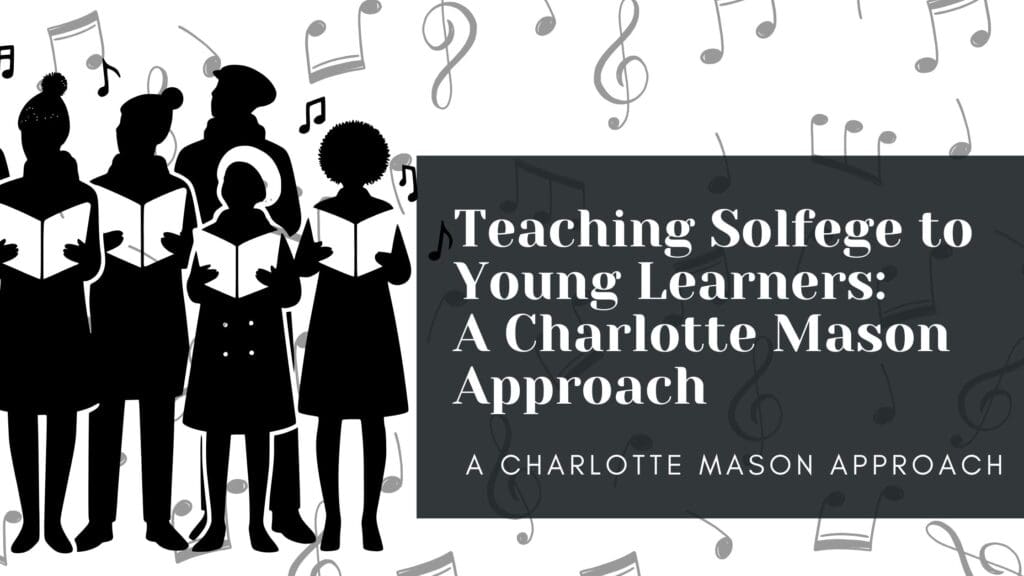If you’re a parent or tutor teaching music to early elementary students, you may have come across the term “solfege.” This musical method, famously associated with “Do-Re-Mi” from The Sound of Music, is a fantastic tool for helping children develop their musical ear, sight-singing skills, and an appreciation for melody. This is a guide is for teaching Solfege to young learners: A Charlotte Mason approach.

In this post, we’ll explore what solfege is, how it benefits young learners, and how Charlotte Mason incorporated it into her educational philosophy.
What Is Solfege?
Solfege is a system of musical notation that assigns syllables to different pitches in a scale. The most common form, movable do solfege, follows this pattern:
- Do
- Re
- Mi
- Fa
- Sol
- La
- Ti
- Do (the octave above)
Each syllable corresponds to a scale degree, making it easier for children to understand relationships between notes rather than just memorizing them.
Benefits of Solfege for Young Learners
- Develops Ear Training – Solfege helps children recognize pitch differences, making it easier for them to sing in tune.
- Enhances Sight-Singing – By associating syllables with notes, children can learn to read music more effectively.
- Builds Musical Confidence – Instead of relying on an instrument, solfege allows children to explore melody with their own voice.
- Encourages Active Engagement – Learning solfege through movement, hand signs, and singing makes music lessons more interactive and enjoyable.
Charlotte Mason’s Use of Solfege
Charlotte Mason, a 19th-century British educator, emphasized a gentle, living approach to education. She advocated for teaching music in a way that was natural, engaging, and delightful for children. In her schools, solfege was an essential part of music appreciation and ear training.
Mason believed in short, consistent lessons where children learned solfege through:
- Singing simple folk songs and hymns using solfege syllables.
- Practicing with Curwen hand signs, which provide a visual and kinesthetic representation of pitch relationships.
- Listening to and imitating melodies before seeing them written down, ensuring a strong auditory foundation before formal music reading.
Her method was rooted in the idea that children should enjoy music naturally, much like learning a language by ear before reading and writing it.
How to Teach Solfege at Home or in Small Lessons
Here are some simple ways you can incorporate solfege into your lessons:
- Start with Singing – Sing the Do-Re-Mi scale with your child daily. Use a piano or an app to help with pitch accuracy.
- Use Curwen Hand Signs – Assign each solfege syllable a specific hand sign to reinforce pitch visually and kinesthetically.
- Play Simple Call-and-Response Games – Sing a short melody using solfege, and have your child repeat it back.
- Introduce Songs with Solfege Syllables – Songs like “Hot Cross Buns” and “Mary Had a Little Lamb” can be sung using solfege syllables to help children recognize note patterns.
- Make It Fun! – Use movement, storytelling, and even props like scarves or puppets to make solfege engaging for young learners.
Final Thoughts
Teaching Solfege to Young Learners: A Charlotte Mason Approach
Teaching solfege doesn’t have to be complicated or intimidating! By using a Charlotte Mason-inspired approach—short, joyful lessons filled with singing and movement—you can help children develop a lifelong love for music. Whether you’re a parent homeschooling your child or a tutor guiding young learners, solfege is a powerful tool for making music education accessible and enjoyable.
For the next step in your child’s musical journey, check out my Rhythm Flash Cards here to help them develop a strong sense of rhythm, or explore my Music for Homeschoolers blog post here for more ideas on incorporating music into your homeschool curriculum.